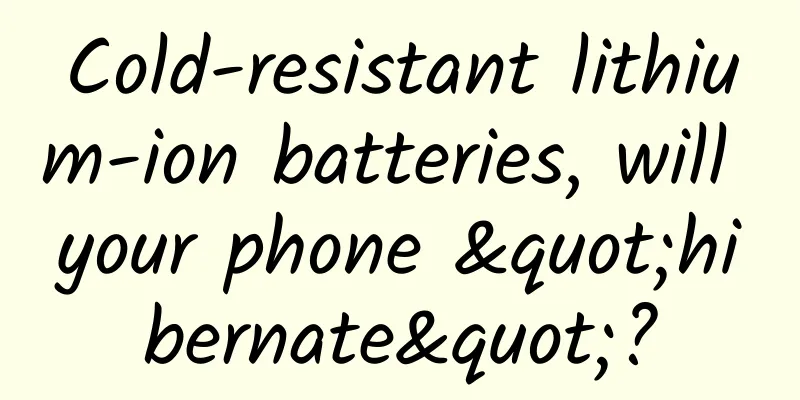Cold-resistant lithium-ion batteries, will your phone "hibernate"?

|
China Science and Technology News Network, December 30 (Xu Qiqi) Have you ever encountered this situation? In winter, you take your fully charged mobile phone out, but it runs out of power before you use it for a short time. This is because the chemical activity of lithium batteries will deteriorate in low temperature environments, and the amount of electricity that can be effectively used is lower than that in normal temperature environments. Recently, a research team composed of scientists from Tianjin University, Beijing Jiaotong University and the Chinese Academy of Sciences discovered a method to allow lithium-ion batteries to work stably in extremely cold environments. They can still be charged even at -35°C and can release nearly 100% of the battery power during the discharge process. Lithium battery is a secondary battery that mainly relies on the movement of lithium ions between the positive and negative electrodes to work. Secondary battery is rechargeable battery, also called storage battery. The main materials of lithium-ion battery are positive electrode, negative electrode, diaphragm and electrolyte, in addition to aluminum foil, copper foil, aluminum plastic film and so on. Lithium-ion batteries have the advantages of light weight, high voltage, high specific energy, fast charging, low self-discharge, long cycle life, good safety performance, etc. Currently, lithium-ion batteries are mainly used in electronic products, electric vehicles and aerospace electronic engineering. At the same time, lithium-ion batteries also have problems such as intolerance to overcharge, intolerance to over-discharge, possible short circuit, and capacity decay due to temperature, etc. Scientists are researching lithium-ion batteries that charge faster, are more cold-resistant, more heat-resistant, and have higher performance. In order to improve the performance of batteries in extremely cold conditions, scientists replaced the graphite anode in lithium-ion batteries with a cobalt-containing zeolite imidazolate framework, and the battery performance became better. Tests found that the anode with the replaced material can also be stably charged and discharged at a temperature of -20°C. When the temperature is slightly below freezing, the battery's storage capacity can reach 85.9% of that at normal room temperature. Even if the temperature drops to -35°C, the battery anode can be charged and release nearly 100% of the battery power. |
>>: Dots of Science | This is the rocket that helped Tianwen-1 land on Mars?
Recommend
What are the projects that can earn over 10,000 yuan a month from a small business? What are the projects that are suitable for starting a business at home?
What are some small business projects that can ea...
Experience the magic of floating in the Dead Sea
On the way to Jerusalem, someone said, "Driv...
The creature on earth that can "drink" the most is actually the bumblebee!
In a corner of nature Hidden a shocking secret Th...
vivo official website App modular development solution-ModularDevTool
Note: This tool is developed based on the open so...
Led by Chinese scientists, Einstein's predictions were confirmed!
The black hole that humans "saw" for th...
Let’s go, “group” to find the shale “underground palace”
In ancient times, people conducted hydrogeologica...
NVIDIA launches Battlebox 4K gaming PC console
The only market that is still growing in the enti...
If you lean on people, they will run away. If you lean on trees, they will fall down. What about if you lean on the wall?
As the old saying goes, If you rely on people, th...
Vitamin C is 4 times that of blueberries. It is known as the "best health fruit of the 21st century". It is the perfect time to eat it now.
Now is the season when mulberries are on the mark...
The product manager of NetEase Cloud Music personally tells: practical experience in each product development stage of Cloud Music!
The topic I want to share with you today is "...
Wireless is better than wired. Can Sony MDR-EX750BT and NW-A25 produce super CD sound quality?
Electronic device enthusiasts have long been seek...
Will money be deducted if the WeChat payment code is photographed?
Now WeChat payment has become an indispensable pa...
Douyin unmanned live square dance, missed the cloud disco, must catch up with the cloud square dance [software + tutorial + material]
Douyin unmanned live square dance, missed the clo...
What is the algorithm of Tik Tok’s recommendation mechanism?
The reason why Tik Tok is so popular is definitel...
What are the benefits and functions of dog meat? How to make dog meat delicious?
Dog meat is very rich in nutritional value, conta...









